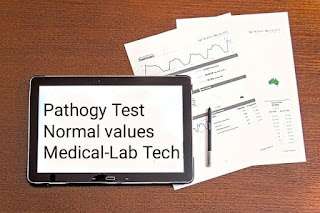Clinical Pathology Test | Normal values
Clinical pathology test is important for diagnosis and assistance in the diagnosis of various diseases its includes urine, CSF, semen analysis.
Clinical Pathology Test | Normal values
Clinical pathology test is important for the diagnosis of various diseases analysis of body fluid. Routine Clinical pathology examination includes urine, CSF, semen analysis, and its normal value to help to know the condition of the patient, Here we going to discuss the various test done in clinical pathology and its reference range.
 |
| Clinical Pathology Test | Normal values |
Clinical pathology test list
- Erythrocyte sedimentation rate
- pack cell volume
- urine analysis
- semen analysis
- CSF analysis
- Coombs test
The normal value of clinical pathology test
Erythrocyte Sedimentation Rate
ESR estimation
Westergren’s method
- M 3-5 mm 1st hour
- F 4-7mm 1st hour
Win Trobe's
- Male 0-7 mm 1st hour
- Female 0-15 mm
Packed Cell Volume
- At birth: 44–63%
- At 1 year: 35%
- At 10 years: 37.5%
- Women: 30–40%
- Men: 40–54%
Urine analysis value
Physical analysis value
- Normal color: clear, pale, or straw-colored
- Volume : 500-1500ml
- Specific gravity: 1.003 to 1.030.
- Odor: faint aromatic odor.
- PH: 4.6-7.0 (average 6.0).
Biochemical values
- Protein Test: NIL
- Bence Jones Protein: NIL
- Glucose Test: NIL
- Ketone Bodies (Ketones) : NIL
- Bilirubin: NIL
- Urobilinogen Test: NIL
- Porphobilinogen In Urine: NIL
Urine Strip –as given by the manufacture
Microscopic (urine)
Cells
- RBCs
- WBCs
- Epithelial cells
Casts
- Hyaline cast
- Red cell cast
- Leukocyte cast
- Granular cast
- Waxy cast
- Fatty cast
- Epithelial cast
- Pigment cast
Crystals
- Calcium oxalate
- Uric acid
- Amorphous urate
- Tyrosine
- Cystine
- Cholesterol crystals
- Sulphonamide
Miscellaneous structures
- Spermatozoa
- Parasite
- Fungus
- Tumor cells
Semen Analysis
This include
- Physical analysis
- Microscopic examination
- Chemical analysis
Other procedures are not done in a pathology lab
Physical analysis
- Color: slightly yellowish or whitish, grey-white
- Volume: 2.5 - 5 ml.
- Viscosity: fairly viscid
- Reaction :7-8
- Liquefaction :15-20 min
Microscopic analysis
- Motility: more than 60%
- Count : > 60 million/ml
- Morphology
Chemical analysis value
- Fructose test : 150-600 mg/dl
- Acid phosphates test: 2500 KA units/ml
Immunology analysis
CSF analysis
Physical
- Appearance: Clear and colorless
- Rate of production: 500 ml/day
- Total volume: 120-150 ml in adults, 10-60 ml in neonates
- Specific gravity: 1.006-1.008
- Normal pressure : 60-150 mm of water in adults, 10-100 mm water in infants
Chemical
- Sugar : 50-80 mg/dl (i.e. 60% of plasma value)
- CSF: Plasma : 0.3-0.9 glucose ratio
- Proteins : 15-45 mg/dl
- Chloride : 720-760 mg% (i.e. same as in plasma)
Blood cells
- RBC : absent
- Cells : 0-4 leucocytes/ml (0-30 leucocytes/ml in neonates)
Microbiological
- Bacteria: Nil
Blood Grouping
- Depend on the agglutination reaction
Rh Typing
- Depend on the agglutination reaction
Coombs’ Test
- Depend on the agglutination reaction
Activated Partial Thromboplastin Time
- 22-34 seconds
Bleeding Time (Ivy Method)
- 1 – 6 minutes